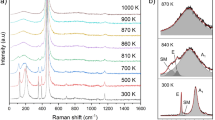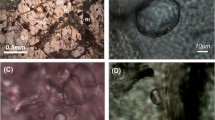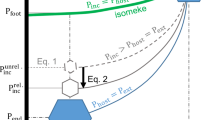Abstract
Garnet crystals with quartz inclusions were hydrothermally crystallized from oxide starting materials in piston–cylinder apparatuses at pressures from 0.5 to 3 GPa and temperatures ranging from 700 to 800 °C to study how entrapment conditions affect remnant pressures of quartz inclusions used for quartz-in-garnet (QuiG) elastic thermobarometry. Systematic changes of the 128, 206 and 464 cm−1 Raman band frequencies of quartz were used to determine pressures of quartz inclusions in garnet using Raman spectroscopy calibrations that describe the P–T dependencies of Raman band shifts for quartz under hydrostatic pressure. Within analytical uncertainties, inclusion pressures calculated for each of the three Raman band frequencies are equivalent, which suggests that non-hydrostatic stress effects caused by elastic anisotropy in quartz are smaller than measurement errors. The experimental quartz inclusions have pressures ranging from − 0.351 to 1.247 GPa that span the range of values observed for quartz inclusions in garnets from natural rocks. Quartz inclusion pressures were used to model P–T conditions at which the inclusions could have been trapped. The accuracy of QuiG thermobarometry was evaluated by considering the differences between pressures measured during experiments and pressures calculated using published equation of state parameters for quartz and garnet. Our experimental results demonstrate that Raman measurements performed at room temperature can be used without corrections to estimate garnet crystallization pressures. Calculated entrapment pressures for quartz inclusions in garnet are less than ~ 10% different from pressures measured during the experiments. Because the method is simple to apply with reasonable accuracy, we expect widespread usage of QuiG thermobarometry to estimate crystallization conditions for garnet-bearing silicic rocks.





Similar content being viewed by others
References
Adams HG, Cohen LH, Rosenfeld JL (1975a) Solid inclusion piezothermometry I: comparison dilatometry. Am Mineral 60:574–583
Adams HG, Cohen LH, Rosenfeld JL (1975b) Solid inclusion piezothermometry II: geometric basis, calibration for the association quartz-garnet, and application to some pelitic schists. Am Mineral 60:584–598
Angel RJ, Mazzucchelli ML, Alvaro M et al (2014) Geobarometry from host-inclusion systems: the role of elastic relaxation. Am Mineral 99:2146–2149. https://doi.org/10.2138/am-2014-5047
Angel RJ, Nimis P, Mazzucchelli ML et al (2015) How large are departures from lithostatic pressure? Constraints from host-inclusion elasticity. J Metamorph Geol 33:801–813. https://doi.org/10.1111/jmg.12138
Angel RJ, Alvaro M, Miletich R, Nestola F (2017a) A simple and generalised P–T–V EoS for continuous phase transitions, implemented in EosFit and applied to quartz. Contrib Mineral Petrol. https://doi.org/10.1007/s00410-017-1349-x
Angel RJ, Mazzucchelli ML, Alvaro M, Nestola F (2017b) EosFit-Pinc: a simple GUI for host-inclusion elastic thermobarometry. Am Mineral 102:1957–1960. https://doi.org/10.2138/am-2017-6190
Ashley KT, Caddick MJ, Steele-MacInnis MJ et al (2014) Geothermobarometric history of subduction recorded by quartz inclusions in garnet: quartz inclusion barometry. Geochem Geophys Geosyst 15:350–360. https://doi.org/10.1002/2013GC005106
Ashley KT, Darling RS, Bodnar RJ, Law RD (2015) Significance of “stretched” mineral inclusions for reconstructing P–T exhumation history. Contrib Mineral Petrol. https://doi.org/10.1007/s00410-015-1149-0
Ashley KT, Steele-MacInnis M, Bodnar RJ, Darling RS (2016) Quartz-in-garnet inclusion barometry under fire: reducing uncertainty from model estimates. Geology 44:699–702. https://doi.org/10.1130/G38211.1
Avadanii D (2017) A new barometer from stress fields around inclusions. PhD thesis, University of Oxford
Bose K, Ganguly J (1995) Quartz-coesite transition revisited; reversed experimental determination at 500–1200 degrees C and retrieved thermochemical properties. Am Mineral 80:231–238. https://doi.org/10.2138/am-1995-3-404
Boyd FR, England JL (1960) The quartz-coesite transition. J Geophys Res 65:749–756. https://doi.org/10.1029/JZ065i002p00749
Castro AE, Spear FS (2016) Reaction overstepping and re-evaluation of peak P–T conditions of the blueschist unit Sifnos, Greece: implications for the cyclades subduction zone. Int Geol Rev. https://doi.org/10.1080/00206814.2016.1200499
Dean KJ, Sherman WF, Wilkinson GR (1982) Temperature and pressure dependence of the Raman active modes of vibration of α-quartz. Spectrochim Acta Part Mol Spectrosc 38:1105–1108. https://doi.org/10.1016/0584-8539(82)80044-5
Enami M, Nishiyama T, Mouri T (2007) Laser Raman microspectrometry of metamorphic quartz: a simple method for comparison of metamorphic pressures. Am Mineral 92:1303–1315. https://doi.org/10.2138/am.2007.2438
Guiraud M, Powell R (2006) P–V–T relationships and mineral equilibria in inclusions in minerals. Earth Planet Sci Lett 244:683–694. https://doi.org/10.1016/j.epsl.2006.02.021
Hemley RJ (1987) Pressure dependence of Raman spectra of SiO2 polymorphs: α-quartz, coesite, and stishovite. In: Manghnani MH, Syono Y (eds) Geophysical monograph series. American Geophysical Union, Washington, DC, pp 347–359
Holland TJB (1980) The reaction albite = jadeite + quartz determined experimentally in the range 600–1200 °C. Am Mineral 65:129–134
Holland TJB, Powell R (2004) An internally consistent thermodynamic data set for phases of petrological interest: an internally consistent thermodynamic dataset. J Metamorph Geol 16:309–343. https://doi.org/10.1111/j.1525-1314.1998.00140.x
Holland TJB, Powell R (2011) An improved and extended internally consistent thermodynamic dataset for phases of petrological interest, involving a new equation of state for solids: thermodynamic dataset for phases of petrological interest. J Metamorph Geol 29:333–383. https://doi.org/10.1111/j.1525-1314.2010.00923.x
Howell D, Wood IG, Dobson DP et al (2010) Quantifying strain birefringence halos around inclusions in diamond. Contrib Mineral Petrol 160:705–717. https://doi.org/10.1007/s00410-010-0503-5
Jakobsson S (2012) Oxygen fugacity control in piston-cylinder experiments. Contrib Mineral Petrol 164:397–406. https://doi.org/10.1007/s00410-012-0743-7
Kitahara S, Kennedy GC (1964) The quartz–coesite transition. J Geophys Res 69:5395–5400. https://doi.org/10.1029/JZ069i024p05395
Kohn MJ (2014) “Thermoba-Raman-try”: calibration of spectroscopic barometers and thermometers for mineral inclusions. Earth Planet Sci Lett 388:187–196. https://doi.org/10.1016/j.epsl.2013.11.054
Kohn M, Spear FS (1991a) Error propagation for barometers: 2. Application to rocks. Am Mineral 76:138–147
Kohn M, Spear FS (1991b) Error propagation for barometers: 1. Accuracy and precision of experimentally located end-member reactions. Am Mineral 76:128–137
Korsakov AV, Perraki M, Zhukov VP et al (2009) Is quartz a potential indicator of ultrahigh-pressure metamorphism? Laser Raman spectroscopy of quartz inclusions in ultrahigh-pressure garnets. Eur J Mineral 21:1313–1323. https://doi.org/10.1127/0935-1221/2009/0021-2006
Kouketsu Y, Nishiyama T, Ikeda T, Enami M (2014) Evaluation of residual pressure in an inclusion-host system using negative frequency shift of quartz Raman spectra. Am Mineral 99:433–442. https://doi.org/10.2138/am.2014.4427
Liu L, Mernagh TP (1992) High-pressure Raman study of the a-quartz forms of Si02 and Ge02 at room temperature. High Temp-High Press 24:13–21
Mazzucchelli ML, Burnley P, Angel RJ et al (2018) Elastic geothermobarometry: corrections for the geometry of the host-inclusion system. Geology 46:231–234. https://doi.org/10.1130/G39807.1
McDade P, Wood BJ, Van Westrenen W et al (2002) Pressure corrections for a selection of piston-cylinder cell assemblies. Mineral Mag 66:1021–1028. https://doi.org/10.1180/0026461026660074
Milani S, Nestola F, Alvaro M et al (2015) Diamond–garnet geobarometry: the role of garnet compressibility and expansivity. Lithos 227:140–147. https://doi.org/10.1016/j.lithos.2015.03.017
Mirwald PW, Massonne H-J (1980) The low-high quartz and quartz-coesite transition to 40 kbar between 600 and 1600 °C and some reconnaissance data on the effect of NaAlO2 component on the low quartz-coesite transition. J Geophys Res 85:6983. https://doi.org/10.1029/JB085iB12p06983
Mirwald PW, Getting IC, Kennedy GC (1975) Low-friction cell for piston-cylinder high-pressure apparatus. J Geophys Res 80:1519–1525. https://doi.org/10.1029/JB080i011p01519
Powell R, Holland TJB (2008) On thermobarometry. J Metamorph Geol 26:155–179. https://doi.org/10.1111/j.1525-1314.2007.00756.x
Rosenfeld JL (1969) Stress effects around quartz inclusions in almandine and the piezothermometry of coexisting aluminum silicates. Am J Sci 267:317–351. https://doi.org/10.2475/ajs.267.3.317
Rosenfeld JL, Chase AB (1961) Pressure and temperature of crystallization from elastic effects around solid inclusions in minerals? Am J Sci 259:519–541. https://doi.org/10.2475/ajs.259.7.519
Schmidt C, Ziemann MA (2000) In-situ Raman spectroscopy of quartz: a pressure sensor for hydrothermal diamond-anvil cell experiments at elevated temperatures. Am Mineral 85:1725–1734. https://doi.org/10.2138/am-2000-11-1216
Sorby HC, Butler PJ (1868) On the structure of rubies, sapphires, diamonds, and some other minerals. Proc R Soc Lond 17:291–302. https://doi.org/10.1098/rspl.1868.0050
Spear FS, Thomas JB, Hallett BW (2014) Overstepping the garnet isograd: a comparison of QuiG barometry and thermodynamic modeling. Contrib Mineral Petrol. https://doi.org/10.1007/s00410-014-1059-6
Trail D, Bruce Watson E, Tailby ND (2012) Ce and Eu anomalies in zircon as proxies for the oxidation state of magmas. Geochim Cosmochim Acta 97:70–87. https://doi.org/10.1016/j.gca.2012.08.032
Van der Molen I, Van Roermund HLM (1986) The pressure path of solid inclusions in minerals: the retention of coesite inclusions during uplift. Lithos 19:317–324. https://doi.org/10.1016/0024-4937(86)90030-7
Wang Z, Ji S (2001) Elasticity of six polycrystalline silicate garnets at pressure up to 3.0 GPa. Am Mineral 86:1209–1218. https://doi.org/10.2138/am-2001-1009
Worley P (2000) High-precision relative thermobarometry: theory and a worked example. J Metamorph Geol 18:91–101. https://doi.org/10.1046/j.1525-1314.2000.00239.x
Yagii T, Akaogi M, Shimomurad O et al (1987) High pressure and high temperature equations of state of majorite. In: Manghnani MH, Syono Y (eds) Geophysical monograph series. American Geophysical Union, Washington, DC, pp 141–147
Zhang Y (1998) Mechanical and phase equilibria in inclusion–host systems. Earth Planet Sci Lett 157:209–222. https://doi.org/10.1016/S0012-821X(98)00036-3
Zhang M, Scott J (2007) Raman studies of oxide minerals: a retrospective on cristobalite phases. J Phys Condens Matter 19:275201
Zhang L, Ahsbahs H, Kutoglu A, Geiger CA (1999) Single-crystal hydrostatic compression of synthetic pyrope, almandine, spessartine, grossular and andradite garnets at high pressures. Phys Chem Miner 27:52–58. https://doi.org/10.1007/s002690050240
Zhukov VP, Korsakov AV (2015) Evolution of host-inclusion systems: a visco-elastic model. J Metamorph Geol 33:815–828. https://doi.org/10.1111/jmg.12149
Acknowledgements
This work was supported by the Earth Sciences Division of the National Science Foundation through grant number EAR-1447468. JT thanks David Adams, Guiomar Camano and Anthony Crespo for assistance on numerous experiments, and Tara Kahan for usage of the Renishaw Raman Spectrometer. Numerous discussions with Mattia Bonazzi, Mateo Alvaro and Ross Angel greatly improved our understanding of inclusions with remnant pressures. Formal reviews by Matthew Kohn, Fabrizio Nestola and an anonymous reviewer greatly improved the final version of the manuscript.
Author information
Authors and Affiliations
Corresponding author
Additional information
Communicated by Mark S. Ghiorso.
Electronic supplementary material
Below is the link to the electronic supplementary material.
Rights and permissions
About this article
Cite this article
Thomas, J.B., Spear, F.S. Experimental study of quartz inclusions in garnet at pressures up to 3.0 GPa: evaluating validity of the quartz-in-garnet inclusion elastic thermobarometer. Contrib Mineral Petrol 173, 42 (2018). https://doi.org/10.1007/s00410-018-1469-y
Received:
Accepted:
Published:
DOI: https://doi.org/10.1007/s00410-018-1469-y




